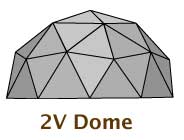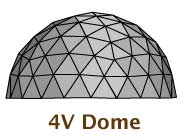Geodesic Domes 2V 3V 4V
In the process of building our geodesic dome tent we used dome formulas to create a 2V geodesic dome. These diagrams compare geodesic domes 2V, 3V, and 4V.
-
Comparison of Geodesic Domes 2v 3V 4V

- Geodesic domes are comprised of a network of triangles that form a somewhat spherical surface. There are several dome classes that are referred to as 1V, 2V, 3V etc. The more complex the network of triangles, the more spherical the geodesic dome and the higher the class number. A 1V dome has fewer triangles, uses only one size triangle in its simple pattern, and less closely approximates a hemisphere. A 6V dome has many triangles of multiple sizes that are arranged in a complex pattern to create a more smooth and spherical shape. Higher class domes offer greater structural stability and are ideal for larger dome frames.
-
Geodesic Dome Formula - 2V

- A 2V geodesic dome is comprised of only two different sized triangles and therefore has a relatively simple construction pattern. It has fewer over all triangles than the 3V and 4V geodesic domes
-
Geodesic Dome Formula - 3V

- A 3V Geodesic Dome is comprised of three triangle sizes and is more complex in its pattern than 1V and 2V domes. 3V domes also have a greater number of triangles than the simpler geodesic domes.
-
Geodesic Dome Formula - 4V

- The 4V geodesic dome is made of 6 triangle sizes and has a complex construction pattern. As a result the 4V dome offer greater structural support than 1V, 2V, and 3V domes.